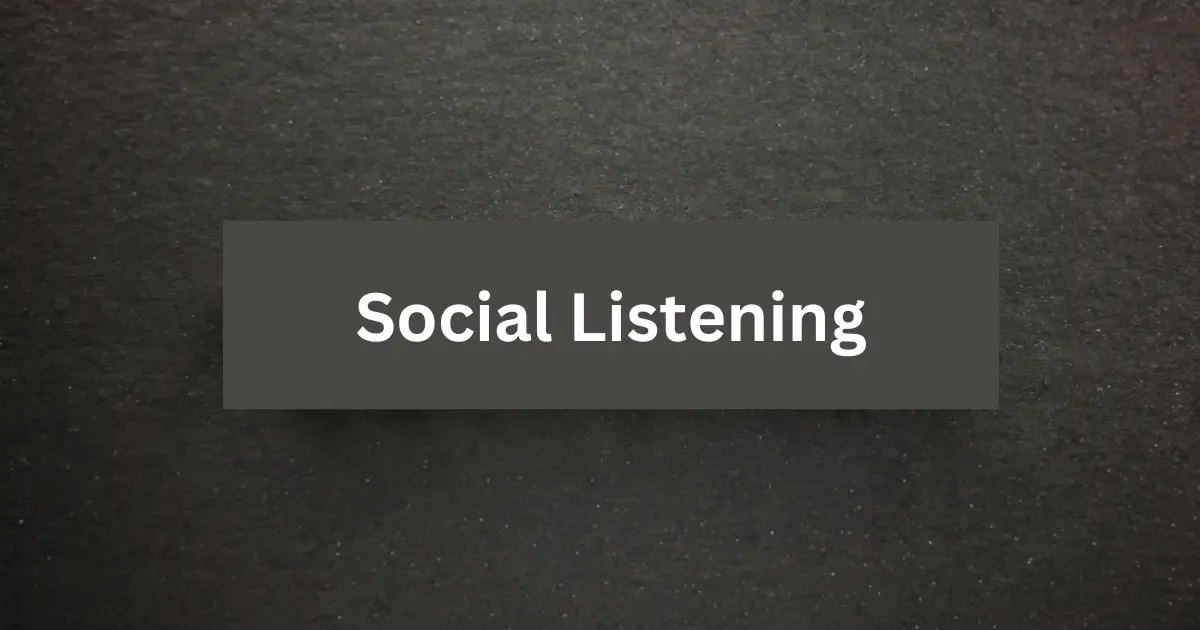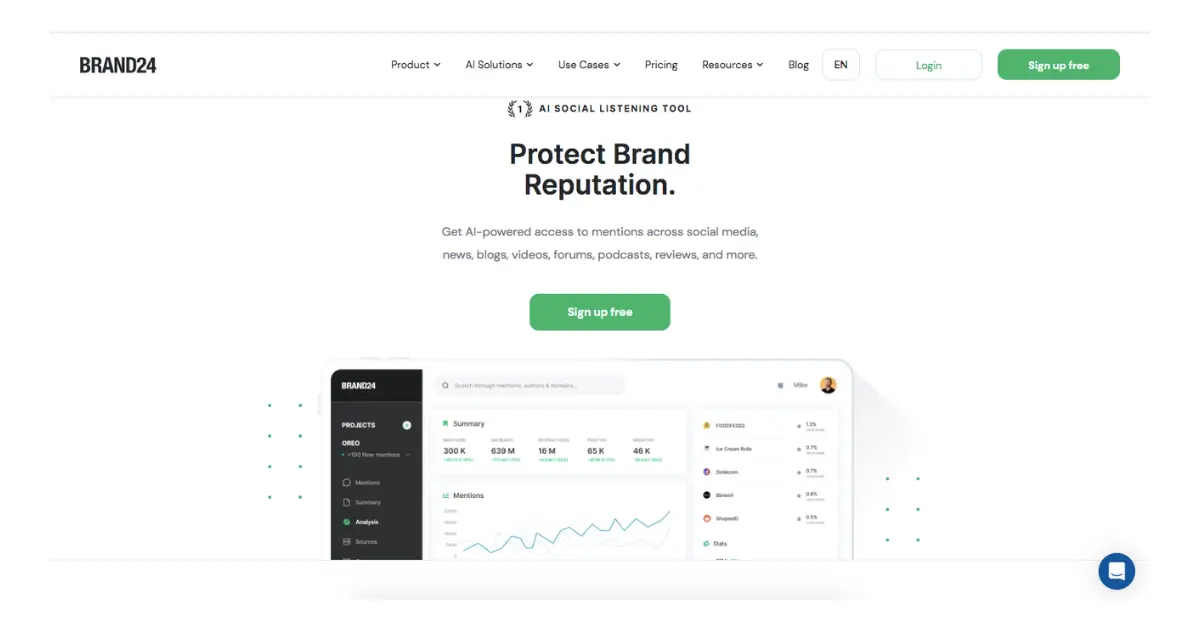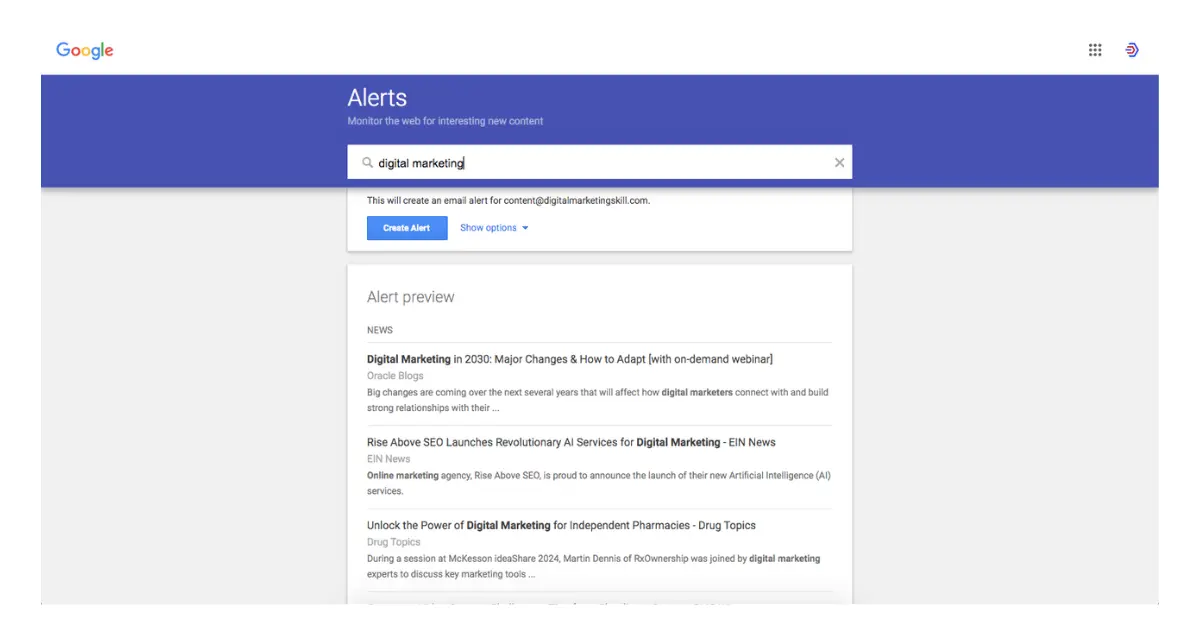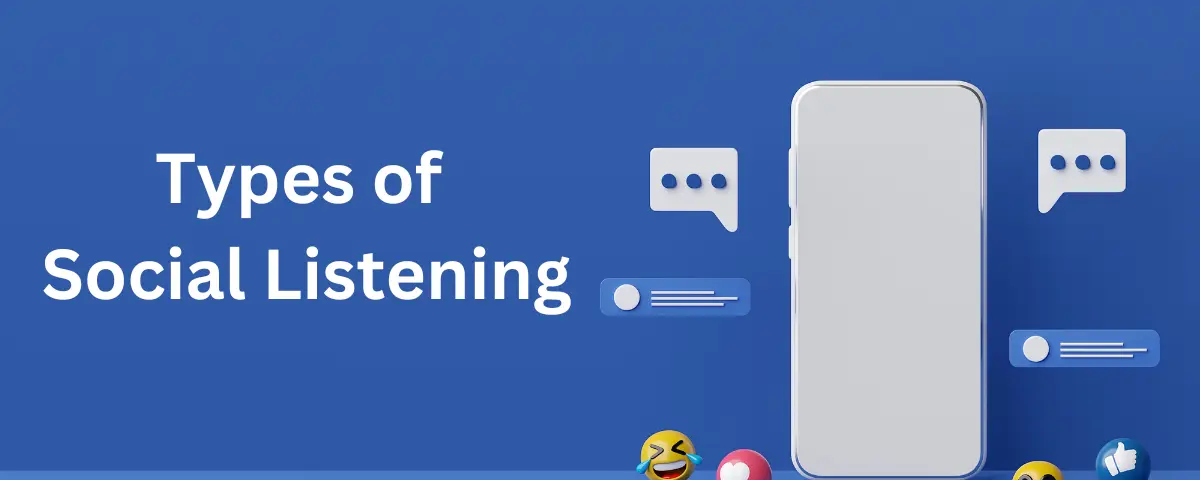Have you ever wondered how some brands consistently stay ahead of the curve, skillfully engaging with their audience and providing precisely what they want? The key to their success is social listening.
Social listening is the practice of monitoring and analyzing online conversations. It provides valuable insights that can greatly impact your marketing strategy and contribute to the success of your business.
When you actively observe and evaluate online discussions about your businesses, you will understand more about your target audiences, predict trends, and implement data-driven choices that propel you to the forefront of their sector.
Using social listening to make some marketing decisions also comes with some complications, and that’s why we teach it in depth in our digital marketing training course (click the link to see course details).
So, in this blog post, you will discover the power of social listening, a valuable technique that allows businesses to understand the needs and preferences of their target audience.
What is Social Listening?

Social listening is the process of monitoring and analyzing conversations happening on social media, forums, and other online channels. This involves tracking mentions of your brand, competitors, specific keywords, topics, and industries. You then analyze this information to gain insights and make decisions.
Social listening goes deeper to understand why people are saying these things. This approach helps businesses identify the underlying sentiment, mood, and motivations driving the conversations. This ultimately helps in developing long-term strategic plans.
Why is Social Listening Important?
Get 50% Discount to Master ALL Aspects of Digital Marketing That Can Earn You $2,500 - $5,000 a month (Even if you are a complete beginner!)
Our students that intentionally implement what they learn from our digital marketing course make back the entire course fee within a single month or more after completing our course because our course gives them many income generating options with unlimited earning potential with no age or location barrier. The best part is no technical skills are required.
An opportunity to change your lifestyle and make money working from anywhere in the world. The results our students get from our digital marketing course prove this could be applied to any market or country and that it is designed for any skill level and work background.
*By signing up, you agree to our privacy policy and terms of service.
Social listening is crucial for you, as a business owner or marketer, to comprehend customer interactions, measure brand awareness, and make data-driven decisions to enhance your products, services, and marketing strategies.
Here are some key benefits of social listening for your business or brand:
1. Data-driven decision making
Social listening gives you valuable insights and data to inform strategic processes in your business or brand. When you analyze conversations on social media platforms, you can conduct market research, pinpoint consumer preferences, and ultimately make informed decisions based on data to enhance business or brand growth.
2. Analysis of Campaigns
You can use it to gauge the effectiveness of your marketing campaigns on social media platforms, thereby offering you valuable insights for enhancing future campaigns.
3. Event monitoring
Social listening enables you to track immediate reactions to particular events, such as virtual conferences, Instagram, or Facebook Live, and make necessary adjustments for the next virtual event based on what you discover from the previous one.
4. Understanding Customer Sentiment
For businesses online, you can use social listening to understand how customers feel by tracking and studying online conversations. This will help your brand monitor what customers are saying about your products or services, and help you make smart choices to improve customer satisfaction and keep customers loyal to your business.
5. Improve Brand Reputation
Social listening allows companies to actively maintain their brand reputation by monitoring and addressing customer feedback, whether it be positive or negative. So, as a marketer you must quickly address customer issues and resolve them, this way, your brand or business can establish trust, enhance customer relationships, and safeguard your brand image.
Social Listening vs Social Monitoring
Social listening and social monitoring are two closely related but separate strategies within the field of social media management. Although they are sometimes used interchangeably, it is important to recognize their distinctions to effectively integrate them into marketing strategies.
Social Monitoring
Social monitoring entails keeping track of references to your brand, comments, and interactions on different social media platforms. Its main purpose is to assess the reach and influence of your brand’s social media efforts and to promptly identify and address customer needs, complaints, and feedback.
Social monitoring is also vital for addressing pressing issues and providing timely responses to customer inquiries. It allows you to maintain awareness of your online presence and effectively engage with your audience.
Social Listening
Social listening is a thorough approach that does more than just watch for individual mentions of your brand. It involves studying large amounts of online data to understand how people feel, what new trends are happening, and how customers behave. The purpose of social listening is to grasp the meaning and reasons behind online conversations, giving you a better understanding of what customers want and need. This allows businesses to make smart choices, improve their brand reputation, and find new opportunities to grow.
How to Build Your Social Listening Strategy
Developing a successful strategy is important for you to extract valuable insights from online discussions and use them to enhance your business’s growth. Below the steps below to create a strong strategy.
1. Establish Clear Goals
Before you start social listening, it’s important to clearly define the specific goals and objectives you want to achieve. What exactly are you hoping to accomplish through social listening?
Some of the goals or objectives may be
- Enhancing customer satisfaction and experience
- Creating content, products, or marketing strategies
- Identifying new target audiences
- Expanding brand partnerships and influencer collaborations
- Monitoring brand reputation and online discussions.
Having clear goals in mind will help you develop the right strategy for your social listening efforts.
2. Choose a Listening Tool
To do social listening effectively, choose tools that are a good fit for your goals and have the features you need to monitor and study online conversations. The right tools can make the process easier and provide helpful insights. Some examples of platforms you could use include Hubspot, Sprout Social, and Zoho. These tools have features that allow you to analyze the sentiment (how people feel) and track specific keywords in conversations.
3. Determine Your Listening Priorities
Once you’ve established your overarching social listening framework, it’s time to determine your specific priorities. What topics, keywords, or conversations are most important for you to monitor? This will depend on your unique business goals and the type of insights you’re hoping to uncover.
For example, if you’re a consumer brand, you may want to prioritize listening for mentions of your products, competitor offerings, and industry trends. On the other hand, if you’re a B2B company, you might focus more on discussions around pain points, challenges, and potential solutions in your target market.
Other keywords to monitor might include:
- Your company and product names
- Industry terms and common practices
- Competitor names and products
- Relevant hashtags and keywords used by your target audience.
You can create alerts for these keywords to monitor discussions and mentions. about your brand. some tools to use include Google Alerts, Brand24, etc. This will help you get the most value out of your social listening efforts and make informed, data-driven decisions to drive your company forward.
4. Participate in Online Conversations
Social listening isn’t just about monitoring conversations – it’s also about actively participating in them. Once you’ve identified the key topics and communities relevant to your business, look for opportunities to engage with your audience in a genuine, valuable way. Communities like Reddit, Quora, Linkedin, and Facebook are good for having conversations.
This could involve responding to customer questions or feedback, sharing your expertise on industry trends, or even starting your discussions around thought-provoking ideas. By actively participating, you’ll not only build stronger relationships with your audience, but you’ll also gain valuable insights that can inform your overall social listening strategy.
5. Keep track of brand mentions and competitor activity
As part of your social listening efforts, keeping a close eye on mentions of your brand and your competitors’ activity is crucial. Monitor and be notified whenever your company, products, or key personnel are mentioned online, whether it’s on social media, in blog posts, or in news articles.
You should also monitor your competitors too – what are they doing well? Where are they falling short? How are their customers responding to their products and services? Staying on top of your competitors’ online presence can help you identify opportunities to differentiate your brand and better serve your target audience.
Finally, remember to analyze both the quantity and quality of brand mentions and competitor activity. A high volume of positive mentions could indicate strong brand loyalty and customer satisfaction, while negative mentions may point to areas for improvement. Use these insights to inform your marketing strategies and product development roadmap.
6. Analyze and interpret data
Once you’ve gathered all your social listening data, it’s time to analyze and interpret the insights you’ve uncovered. Look for patterns, trends, and themes that emerge from the conversations you’ve been monitoring. What are the common pain points, questions, or concerns that your audience is expressing?
Seeing how people feel about your brand online can help you a lot. You can categorize mentions of your brand or products as positive, negative, or neutral to get a sense of how your audience feels about you overall. This can help you identify areas for improvement and celebrate your successes.
Remember, data is only as valuable as the insights you can extract from it. Take the time to dig into your social listening data, ask questions, and draw connections. The more you can uncover about your audience’s needs and preferences, the better equipped you’ll be to create products, services, and marketing campaigns that truly resonate with them.
7. Update and Improve
Social listening is an ongoing process, not a one-time event. As your business and the market landscape evolve, it’s important to regularly review and update your social listening strategy to ensure it remains effective and relevant.
Take time to assess the insights you’ve gathered so far. What’s working well, and where are there opportunities for improvement? Maybe you need to adjust your keyword tracking, expand the platforms you’re monitoring, or refine your data analysis approach.
Don’t be afraid to experiment and try new things – the more you can learn and optimize your social listening, the more value it will provide to your business.
Remember, social listening is a powerful tool, but it’s only as good as the actions you take based on the insights you uncover. Stay agile, keep an open mind, and be willing to make changes as needed.
Types of Social Listening
1. Basic or Fundamental Social Listening
Basic social listening entails observing the activity of your own audience on social media platforms, including their engagement with your content and brand pages. This enables a broad understanding of current reactions and sentiment, though it may not provide in-depth audience insights.
2. Deep Social Listening
Deep social listening extends beyond simply monitoring mentions of your brand. It entails monitoring a wide array of discussions across social media pertaining to your industry, competitors, and relevant subjects – even if they do not directly reference your brand. This approach offers a more holistic perspective of the larger conversations taking place.
3. Combined Social Listening
Integrated social listening combines the monitoring of brand metrics with the analysis of industry conversations. It combines quantitative data from social media monitoring with qualitative insights from in-depth social listening.
Social Listening Tools
When it comes to social listening, having the right tools in your hands can make all the difference. There are a variety of platforms and software options available that can help you effectively monitor, analyze, and act on the conversations happening online about your brand, industry, and competitors.
Hootsuite
This platform allows you to track mentions of your brand, keywords, and hashtags across multiple social networks, all in one centralized dashboard. Hootsuite also offers sentiment analysis and reporting features to help you better understand the context and tone of the conversations you’re monitoring.
Brand24

Brand24 is a media monitoring and analytics tool that tracks online mentions of your brand, competitors, and industry keywords. It provides real-time insights into customer opinions, sentiment, and trends, helping you stay on top of your online presence and make data-driven decisions.
Sprout Social
This tool provides robust social media management and analytics capabilities, including the ability to listen for relevant conversations, identify influencers, and measure the performance of your social media efforts.
Zoho
For those looking for a more affordable solution, Zoho Social is worth considering. This platform offers many of the same social listening features as its more expensive counterparts, such as keyword tracking, competitor analysis, and team collaboration tools. Zoho Social is a great choice for small businesses or startups looking to dip their toes into social listening.
Google Alerts

This is a free tool that sends automatic notifications when new content matching your specified keywords is published online. It’s a great way to stay up-to-date on topics that interest you, such as:
- Your name or brand
- Industry news and trends
- Competitors and market developments
- Personal interests and hobbies
With Google Alerts, you can:
- Set up custom alerts with specific keywords
- Receive email notifications when new content is published
- Stay informed and up-to-date on topics that matter to you
Social Listening Example
Netflix
Netflix is a prime example of a company that excels at social listening. As a leading streaming platform, Netflix closely monitors online conversations to better understand its audience and stay ahead of industry trends.
By using social listening tools, Netflix tracks mentions of its brand, content, and competitors across various social media channels. This allows the company to gather valuable insights into what its viewers are talking about, what they like or dislike, and what new shows or movies they’re excited about.
Netflix then leverages these insights to inform its content strategy, marketing campaigns, and even product development. The company is known for its ability to create trending, relatable content that resonates with its millennial-heavy audience. This deep understanding of its customers, cultivated through social listening, is a key driver of Netflix’s continued success and growth.
Challenges Associated with Social Listening
Social listening is a valuable tool for you to gain an understanding of your target audience, industry trends, and competitors. However, it also presents its own set of difficulties. Below are 4 challenges associated with it.
1. Data Overload
Social listening involves monitoring online conversations to gather valuable insights about your brand, industry, and competitors. While there’s more data available than ever, the sheer volume can make it challenging to separate useful insights from irrelevant information. To overcome this, businesses need to employ sophisticated analytics tools and methodologies to efficiently analyze and interpret the data at their disposal.
2. Difficulty of Analysis
Analyzing social media interactions, also known as active web listening, involves examining a large volume of unstructured text from different sources like social media, blogs, forums, and commercial websites. The complexity of analyzing various topics and sentiments across these platforms can present a significant challenge. To overcome this, it’s important to analyze the data properly to extract valuable information that can inform business decisions and strategies.
3. Taking Action
The ability to take action is a major obstacle in social listening, as it requires transforming data and insights into practical strategies and actions that positively impact the business. Without actionable insights, social listening efforts can be ineffective and fail to produce significant results.
So, to address this issue, business owners or marketers need to prioritize setting clear objectives and goals for their initiatives, and establish a framework for analyzing and interpreting the data gathered. Therefore, by concentrating on a professional tone, businesses can enhance their practices and drive success.
4. Privacy and Ethical Concerns
When doing social listening, it’s important to maintain privacy and ethical standards. Businesses must carefully balance collecting valuable consumer insights with protecting individuals’ privacy. Organizations should have clear guidelines to ensure data is ethically collected and used. Upholding user privacy rights and practicing transparency are essential.
Incorporating Social Listening into Your Marketing Plan
When you integrate social listening it into your overall marketing strategy, it can offer valuable insights and improve the efficiency of your marketing campaigns. Therefore, consider using it in the following ways:
Enhance Content Strategy
Social listening can help you understand better how your audience sees your brand and content. After that, you can use this data to make your content more effective, build more accurate buyer personas, and carry out better digital strategies. To improve your content, create relatable content that your audience likes and solve their needs.
Influence Marketing Decisions
When you monitor what people are saying about your brand, It can impact your business decisions, such as marketing strategies, product development, customer service, and support. So analyze any discussions about your brand, products, industry, and competitors to make informed decisions that benefit your business.
Crisis Management
Effective crisis management involves using social listening to detect potential issues or crises at an early stage. This can help the brand to be proactive and promptly address the concerns, minimize damage, and safeguard their brand’s reputation.
The Future of Social Listening
The future of social listening is set to experience numerous trends and innovations that will revolutionize how businesses interpret and interact with their target audiences. Here are some of them:
Predictive Analysis and Trend Prediction
The use of social listening is on the rise for predicting future trends through analyzing ongoing conversations and monitoring their progression. This tool can inform content strategy, product innovation, and marketing tactics, enabling businesses to proactively anticipate changes in consumer behavior and preferences.
Natural Language Processing (NLP)
Natural Language Processing (NLP) algorithms play a crucial role in improving sentiment analysis by enabling machines to understand and interpret human language. These algorithms are specifically created to analyze text data, recognize patterns, and ascertain the sentiment or emotional tone of the text. So, by incorporating NLP algorithms, businesses can acquire valuable insights into customer opinions, preferences, and behaviors. This information can be utilized to make informed decisions, improve customer satisfaction, and enhance overall business performance.
Integration with other Data
As it progresses, the integration of various data sources is becoming a crucial trend for the future. By merging social media data with inputs from CRM systems, customer feedback, and market research, businesses can achieve a deeper understanding of their target audience. This integration enables a more comprehensive analysis of trends, opportunities, and informed decision-making. Furthermore, using this integrated approach allows for a more holistic understanding of the market landscape.
The Bottom Line
Social listening has evolved from just monitoring brand mentions to becoming a valuable strategic tool for businesses. It’s extremely important because it provides crucial insights into what consumers think, what’s happening in the market, and what competitors are doing.
When you actively monitor and participate in online discussions, businesses can gain a deeper understanding of their target audience, predict upcoming trends, and make informed decisions to shape their marketing strategies.
To stay relevant and learn how to use social listening in your marketing strategy, you can check out our digital marketing course page, to know how you can acquire the right data and analyze it to grow your business.
FAQs
Why do we need social listening?
Social listening is needed for businesses as it enables them to comprehend customer attitudes, monitor brand perception, keep tabs on competitor actions, and spot emerging trends. When you monitor online discussions, businesses can acquire valuable insights that guide strategic decision-making, improve customer interaction, and develop effective marketing strategies.
Is social listening a KPI?
Social listening is an important metric for businesses to consider as a key performance indicator (KPI). It evaluates the amount of engagement and interaction with social media content, such as likes, comments, shares, and other forms of engagement. By integrating social listening data into business KPIs, companies can ensure the effectiveness of their marketing efforts and evaluate how they contribute to achieving business objectives.
Further Reading
What is Personalized Marketing & How Can You Excel at It?
How to Grow Your Small Business Using Instagram in 2024





